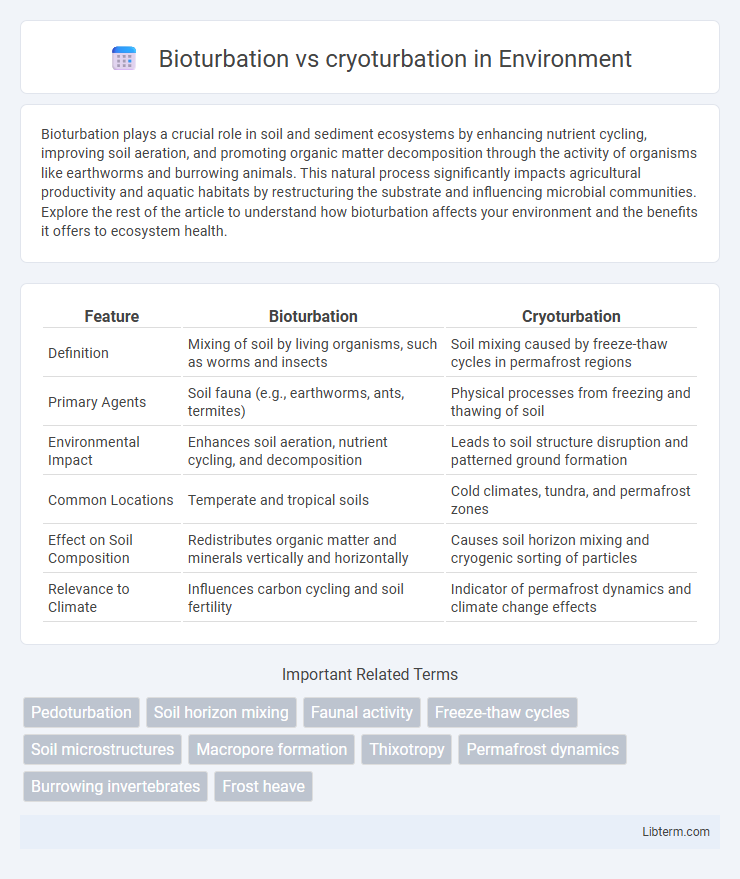Bioturbation plays a crucial role in soil and sediment ecosystems by enhancing nutrient cycling, improving soil aeration, and promoting organic matter decomposition through the activity of organisms like earthworms and burrowing animals. This natural process significantly impacts agricultural productivity and aquatic habitats by restructuring the substrate and influencing microbial communities. Explore the rest of the article to understand how bioturbation affects your environment and the benefits it offers to ecosystem health.
Table of Comparison
| Feature | Bioturbation | Cryoturbation |
|---|---|---|
| Definition | Mixing of soil by living organisms, such as worms and insects | Soil mixing caused by freeze-thaw cycles in permafrost regions |
| Primary Agents | Soil fauna (e.g., earthworms, ants, termites) | Physical processes from freezing and thawing of soil |
| Environmental Impact | Enhances soil aeration, nutrient cycling, and decomposition | Leads to soil structure disruption and patterned ground formation |
| Common Locations | Temperate and tropical soils | Cold climates, tundra, and permafrost zones |
| Effect on Soil Composition | Redistributes organic matter and minerals vertically and horizontally | Causes soil horizon mixing and cryogenic sorting of particles |
| Relevance to Climate | Influences carbon cycling and soil fertility | Indicator of permafrost dynamics and climate change effects |
Introduction to Bioturbation and Cryoturbation
Bioturbation refers to the reworking of soils and sediments by living organisms such as earthworms, insects, and burrowing animals, significantly influencing soil structure, nutrient cycling, and microbial activity. Cryoturbation describes the physical mixing of soils caused by freeze-thaw processes in permafrost and cold environments, leading to patterned ground formation and soil horizon disruption. Both processes play crucial roles in soil development, with bioturbation driven by biological activity and cryoturbation by thermal dynamics.
Defining Bioturbation: Biological Soil Mixing
Bioturbation refers to the process of biological soil mixing caused by the activities of organisms such as earthworms, ants, and burrowing animals, which redistribute soil particles and organic matter. This biological disturbance enhances soil aeration, nutrient cycling, and microbial activity, significantly impacting soil structure and fertility. In contrast, cryoturbation involves physical soil mixing driven by freeze-thaw cycles in cold environments, resulting in soil particle displacement without biological influence.
Explaining Cryoturbation: Freeze-Thaw Soil Dynamics
Cryoturbation refers to the freeze-thaw processes in soil that cause mixing and displacement of soil layers, creating patterned ground and soil horizons disrupted by frost action. This natural mechanism significantly affects soil structure and nutrient distribution in cold environments, as ice formation expands soil particles and permafrost dynamics alter organic matter decomposition. Unlike bioturbation, which involves biological activity like earthworm mixing, cryoturbation is driven by physical freeze-thaw cycles impacting soil texture and landscape morphology.
Key Differences Between Bioturbation and Cryoturbation
Bioturbation involves the mixing of soil and sediment by biological activity such as earthworms and burrowing animals, significantly enhancing soil aeration and nutrient cycling. Cryoturbation occurs in permafrost regions and results from freeze-thaw cycles that physically disrupt soil layers, affecting soil structure and organic matter distribution. Key differences include the biological agents driving bioturbation versus the physical freeze-thaw processes in cryoturbation, as well as their distinct ecological impacts on soil properties and nutrient dynamics.
Environmental Factors Influencing Each Process
Bioturbation is primarily influenced by biological activity, soil moisture, and temperature, where organisms such as worms, insects, and roots mix soil layers, enhancing aeration and nutrient cycling. Cryoturbation occurs mainly in cold environments, driven by freeze-thaw cycles, permafrost dynamics, and soil moisture variations, causing physical mixing and disruption of soil horizons. Both processes are sensitive to environmental factors but differ in their mechanisms, with bioturbation relying on living organisms and cryoturbation depending on thermal and moisture fluctuations in frozen soils.
Impacts on Soil Structure and Composition
Bioturbation enhances soil structure by mixing organic matter and minerals through the activity of soil organisms, increasing aeration and nutrient availability. Cryoturbation disrupts soil layers via freeze-thaw cycles, causing physical mixing that affects soil porosity and nutrient distribution. These processes differently influence soil composition, with bioturbation promoting biological activity and cryoturbation driving physical rearrangement in cold environments.
Effects on Nutrient Cycling and Soil Fertility
Bioturbation enhances nutrient cycling and soil fertility by mixing organic matter and minerals through the activity of soil organisms like earthworms and insects, promoting microbial activity and nutrient availability. Cryoturbation disrupts soil layers through freeze-thaw cycles, causing the mixing of organic and mineral layers but often slowing decomposition and nutrient mineralization in permafrost-affected soils. The contrasting impacts of bioturbation and cryoturbation create distinct soil nutrient dynamics, with bioturbation generally increasing fertility and cryoturbation limiting nutrient accessibility in cold environments.
Ecological Significance in Different Biomes
Bioturbation enhances soil nutrient cycling and aeration in temperate and tropical forests by burrowing organisms, promoting plant growth and microbial diversity. Cryoturbation, prevalent in tundra and permafrost regions, redistributes organic material through freeze-thaw cycles, influencing carbon storage and soil structure stability. Both processes critically shape soil ecosystems, affecting biome-specific ecological functions such as carbon sequestration and habitat sustainability.
Human Activities and Their Influence on Soil Mixing
Human activities such as agriculture, construction, and deforestation significantly intensify bioturbation by increasing soil disturbance through tillage, earthmoving, and root system alteration. Cryoturbation, driven by freeze-thaw cycles in permafrost regions, is indirectly affected by human-induced climate change, which alters soil temperature regimes and disrupts natural soil mixing patterns. Understanding the differential impact of anthropogenic actions on bioturbation and cryoturbation is essential for predicting soil structure dynamics and managing ecosystem services.
Future Perspectives and Research Directions
Emerging research on bioturbation and cryoturbation highlights their critical roles in soil carbon cycling and ecosystem resilience under climate change. Advances in molecular techniques and remote sensing are expected to enhance the quantification of these processes across diverse biomes, facilitating improved predictive models. Future studies should prioritize integrating bioturbation and cryoturbation dynamics into climate models to better understand their impacts on permafrost thaw and global carbon budgets.
Bioturbation Infographic

 libterm.com
libterm.com